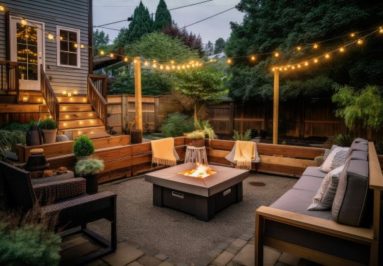What Is Airborne Noise?
Airborne noise or airborne sound is defined as any sound that is transmitted by the air, like music or speech. Sound waves are picked up and carried by air until they crash into something solid, like a wall. The collision sends vibrations through the wall and into the space beyond it. This is why you’re able to hear your neighbor’s dog barking as if it were inside your home; the sound waves created are carried by air until they reach your walls and vibrate through them.
While it is impossible to eliminate all airborne noise, there are a number of ways to greatly reduce it.
How To Reduce Airborne Sound
Reducing Airborne Noise Can be done in a number of ways, but it will usually involve the following:
- Sealing sound leaks
- Adding mass to your walls, windows and doors.
Anywhere gaps are present, sound is going to find its way into your space. Also, anywhere you have a low STC material, such as glass or hollow-core doors, some sound will still be able to pass through.

Seal Sound Leaks from Airborne Noise
The first thing you’ll want to do is check for sound leaks, or sound flanking, in your walls. Even the smallest cracks allow airborne noise to enter your space easily, so be meticulous in your search. Windows and doors tend to be the most susceptible areas, but any gaps will allow a significant amount of airborne noise into your space. After you have located these weak spots, fill them in with acoustical caulk to prevent sound flanking.
If you’re soundproofing a wall during construction so that it mitigates more airborne sound, be sure to use STC rated putty pads on the back of electrical boxes. Otherwise, sound flanks right through the outlets and light switch boxes to the other side of the wall.
Add Mass to Your Wall to Reduce Airborne Sound Transmission
If your airborne sound problem is extreme, or if it is coming from inside the building itself via pipes and other mechanical noise sources, it may require a more intricate fix. The Wall Blokker and Wall Blokker Pro are engineered to mitigate a wide range of frequencies for superior noise reduction. These sound reduction materials are designed for installation behind a finished wall during construction or between an existing wall and a new layer of drywall during renovations.
When using Wall Blokker or any other mass loaded vinyl to soundproof a wall, you’ll have to cut around penetrations including outlet boxes and light switch boxes. In order to prevent airborne noise from passing through the finished wall, the gap between the MLV and the penetration you’ve cut around cannot be any larger than 1/4″, and should be filled with acoustical caulk. Also, seal any horizontal seams in the MLV or any seams that don’t butt up to one another on a stud using seam seal tape.

Use Soundproof Curtains to Reduce Outside Noise
Glass is always going to have a lower STC rating than the exterior walls of a house, so if you are hearing unwanted outside noise, that noise is very likely coming in through the windows.
If airborne noise such as traffic noise is coming in through the windows, consider installing a soundproofing curtain. Soundproof curtains are made using a light mass loaded vinyl that can add mass to your windows while also being flexible enough to bend like a curtain.
Doors also tend to have low STC ratings, especially if they’re hollow core doors, which is the kind most residential homes have. Airborne sound will usually come in under, around and through a door, which is why it’s important to treat the entire door with soundproofing materials. Use door seals around the perimeter of the doorway, and a door sweep to seal the gap at the bottom of the door.
Finally, use a soundproof door cover to add mass to the door and keep sound from traveling through it.
Airborne Noise Explained – How to Reduce It
In summary, airborne noise is something that’s made from airborne sound waves such as speech, music, etc. You can soundproof against airborne noise by sealing up sound leaks to prevent sound flanking, adding mass to your walls and windows using MLV products, as well as soundproofing your doors.





